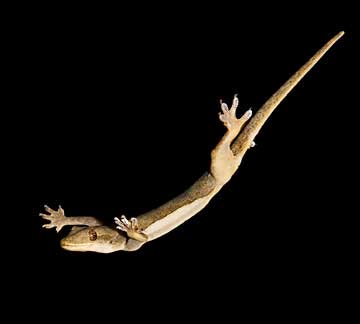Falling With Style: Geckos Count on Tails

For a long time, biologists thought a main function of geckos' tails was to store fat, but a new study gives that couch-potato image a makeover.
In fact, the tail plays an active role in the gecko's amazing ability to climb — for which their sticky feet usually get all the credit — as well as to fall safely.
Ardian Jusufi, his graduate advisor Robert J. Full, and two colleagues, all at the University of California, Berkeley, videotaped flat-tailed house geckos ascending a vertical wall. The team observed that when the lizards' front feet hit a slippery patch and lost their grip, the animals instantly tapped their tails to the wall to keep from pitching backwards. If a tap wasn't enough, they pressed their tails against the wall, like kickstands.
Tailless individuals had much less success traversing the slick spot than intact animals. (Geckos can jettison their tails when snagged by a predator.)
The researchers also observed gecko tail action in the air: they either dropped the lizards from an upside-down position, or set them afloat in a wind tunnel. By actively rotating their tails, turned-over geckos took just one-tenth of a second to roll right side up — the fastest air-righting response ever reported for an animal without wings. Again, intact geckos outperformed tailless ones.
After self-righting, the geckos calmly glided belly first in a typical skydiving posture, moving their tails to control their direction and angle of descent into a safe landing. Fat storage, my tail!
The research was detailed in the Proceedings of the National Academy of Sciences.
Get the world’s most fascinating discoveries delivered straight to your inbox.


